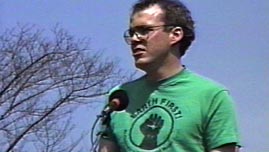Teachers' Domain - Digital Media for the Classroom and Professional Development
User: Preview

Source: Cambridge Community Television
Environmentalist Bill McKibben speaks about humanity's relationship with nature in this archival news footage from 1990. At an Earth Day celebration in Cambridge, MA, McKibben discusses how modern lifestyles are intertwined with climate change and environmental problems. He states that there are no simple ways to save Earth; instead, it will take a sustained effort to preserve the planet. He expresses that there are limits to Earth's resources and that the United States and other developed nations need to share their technology and wealth so that other countries can take less environmentally destructive paths toward development. In addition, he articulates that humans are not the only creatures on the planet and that people have a responsibility to take care of all of Earth's ecosystems.
This video is primary source footage and has not been extensively edited.
Humans are just one of millions of species that live on Earth, but we have a disproportionate impact on the planet. We depend on Earth's natural resources—such as air, water, minerals, plants, and animals—for all aspects of our lives, and our behaviors significantly affect the natural environment. Human activities produce pollution that can be harmful both to human health and the environment. We clear forests, mine minerals, farm land, hunt, and fish—all of which have environmental ramifications. In addition, some of the natural resources that we use, such as fossil fuels, are nonrenewable and cannot be replaced once they are gone.
The environmental movement is a broad term to describe the social, political, and scientific efforts to address the relationship between humans and nature. It incorporates a range of beliefs, from the casual participant who chooses to recycle to extreme environmental activists. In the United States, the conservation movement began in the 19th century as fossil fuel consumption and pollution increased with the Industrial Revolution. As people became more aware of their impact on the environment, they developed an interest in protecting and managing natural resources. The goal was that, through conservation and sustainable practices, resources would be available for future generations.
John Muir, an early advocate of conservation, founded the Sierra Club in 1892 with the intent to protect wilderness areas and to promote the responsible use of Earth's resources. The Sierra Club continues to be an important and well-known conservation organization today. The National Audubon Society, established in 1905, is another early conservation organization that is still active, with a focus on the conservation of birds and wildlife. The National Park Service, founded in 1916, is a U.S. federal agency that manages the national parks as well as other conservation and historic properties and has similar goals of preservation, recreation, and education.
The ideas of conservationism and environmentalism entered political debates in the early 20th century. Although there are no universal definitions, environmentalism differs from conservationism in that it is an ideology that advocates the protection of the environment for its own sake, rather than for sustainable use by humans. The modern environmental movement advanced in 1962, when biologist Rachel Carson published the book Silent Spring. The book looked at the environmental impacts of widespread pesticide use and questioned the use of chemicals without fully understanding their effects on human health and the environment. It had a powerful influence on public opinion and, in 1970, the Environmental Protection Agency, a governmental organization dedicated to protecting human health and the environment, was created. Earth Day, an annual event to raise awareness of environmental issues, was established April 22, 1970. It began as an educational event to increase appreciation for Earth's natural resources and is now observed in most countries around the world. In 2007, Bill McKibben (the environmentalist featured in the video) founded 350.org, an organization that is building a global movement to raise awareness about global climate change and the need to reduce greenhouse gas emissions. Its name was derived from a target atmospheric carbon dioxide concentration of 350 parts per million, which some scientists think may be the tipping point for drastic climate change.
Here are suggested ways to engage students with this video and with activities related to this topic.
 Loading Standards
Loading Standards